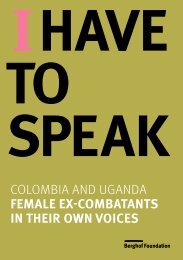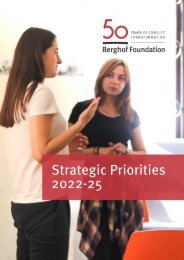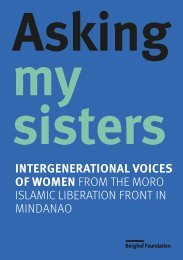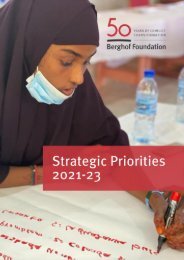Berghof Foundation: 50 years of conflict transformation
This book provides an overview of the Berghof Foundation’s work and impact over the past 50 years and sheds light on the challenges ahead of peacebuilding.
This book provides an overview of the Berghof Foundation’s work and impact over the past 50 years and sheds light on the challenges ahead of peacebuilding.
Create successful ePaper yourself
Turn your PDF publications into a flip-book with our unique Google optimized e-Paper software.
Voices<br />
<strong>of</strong> peace<br />
educators<br />
Interview<br />
Dr Hanan<br />
Madanat and<br />
Dr Leban Serto<br />
Dr Hanan Madanat is Acting<br />
Dean <strong>of</strong> the Faculty <strong>of</strong><br />
Languages and Communication<br />
at the American University<br />
<strong>of</strong> Madaba and partner in our<br />
project “Civic and Nonviolent<br />
Education in Jordan”<br />
Why is peace education important?<br />
Dr Hanan Madanat: If we want to change<br />
the world, we need to start with ourselves and make<br />
peace education a priority in our homes and in the<br />
educational institutions where our children and youth<br />
spend most <strong>of</strong> their time. Peace education helps<br />
young people increase their knowledge about peace,<br />
improve their skills in the area <strong>of</strong> peace, and form an<br />
attitude about the meaning <strong>of</strong> peace in human life. It<br />
can have a positive transformative power on students<br />
and children.<br />
I experience this first-hand at the American<br />
University <strong>of</strong> Madaba, where I have seen peace<br />
education activities strengthen the students’ role as<br />
peacebuilders as it provides them with effective tools<br />
to resolve <strong>conflict</strong> through dialogue. It also promotes<br />
values <strong>of</strong> respect, tolerance and acceptance,<br />
and reduces prejudices and stereotypes. This is<br />
particularly relevant for us at the American University<br />
<strong>of</strong> Madaba with its student body representing<br />
around 28 nationalities. Through peace education<br />
workshops and training, students changed their<br />
conceptions <strong>of</strong> “self” and <strong>of</strong> “other” and have started<br />
to internalise a collective identity, which I believe to<br />
be one <strong>of</strong> the main reasons why our campus is free<br />
<strong>of</strong> violence.<br />
Dr Leban Serto is a peace<br />
researcher and peace education<br />
activist in Northeast India.<br />
He was a partner in the Peace<br />
Counts exhibition (see page 102).<br />
After ten <strong>years</strong> <strong>of</strong> working together, how has the<br />
collaboration with the <strong>Bergh<strong>of</strong></strong> <strong>Foundation</strong> influenced<br />
your peace education work?<br />
Dr Leban Serto: I think two experiences<br />
stand out in particular. The first one was my<br />
participation at the Peace Counts training <strong>of</strong><br />
trainers in Delhi in 2009, which brought together<br />
peacebuilders from Mumbai, Northeast India and<br />
Orissa. Working with stories from around the world<br />
in an experiential and didactic way brought freshness<br />
and vigour to our peace education movement in India<br />
and opened up new opportunities for our work. We<br />
returned home energised and immediately started<br />
reaching out to teachers and communities and<br />
created a network around the Peace Counts stories.<br />
From 2013 to 2015 and with the support <strong>of</strong><br />
the <strong>Bergh<strong>of</strong></strong> <strong>Foundation</strong>, we conducted 25 workshops<br />
in different territories and also across the border<br />
in Thailand and Myanmar. We also managed to<br />
establish a peace education course for MA students<br />
at the Martin Luther Christian University, where I<br />
teach, that includes material and methods from the<br />
Peace Counts project.<br />
The second experience was my visit to<br />
Germany to the <strong>Bergh<strong>of</strong></strong> <strong>Foundation</strong>’s Georg Zundel<br />
House in 2011. During that visit, I learned more<br />
systematic ways <strong>of</strong> doing peace education and got to<br />
know a rich archive <strong>of</strong> multimedia materials, cartoons<br />
and CDs, which have greatly enriched my workshops.<br />
After the experience in Tübingen, I felt empowered<br />
and more confident when I reached out to people,<br />
especially community leaders, who are <strong>of</strong>ten critical<br />
at first. But when I ask them to narrate their own<br />
stories they open up.<br />
At times this can be very emotional, when<br />
people connect their own life to the stories in the<br />
Peace Counts exhibition. I once had a participant<br />
who just stood there and looked at the pictures for<br />
a very long time with tears in his eyes. The stories<br />
really touch people.<br />
105










